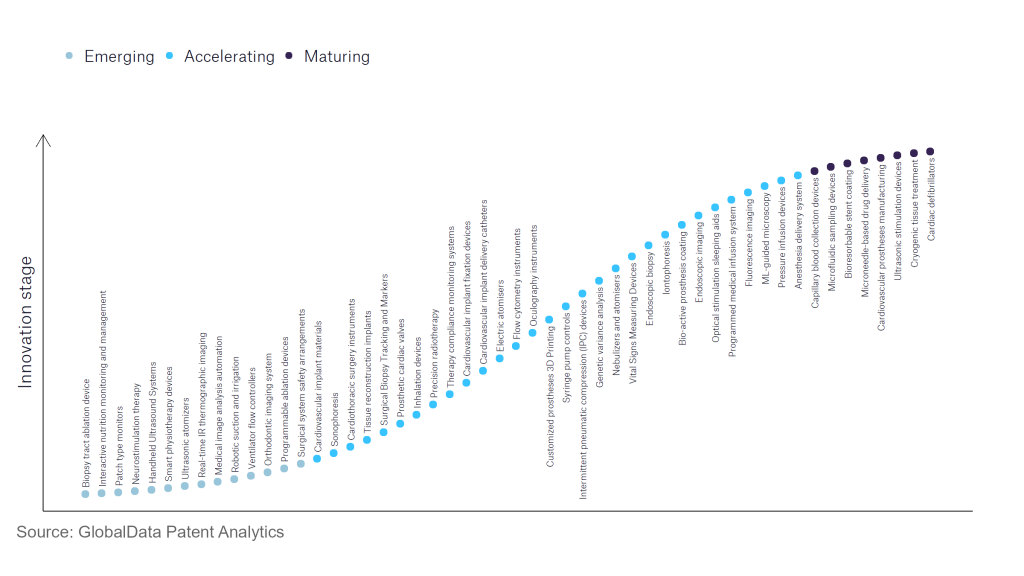The medical devices industry continues to be a hotbed of innovation, with activity driven by increased need for homecare, preventative treatments, early diagnosis, reducing patient recovery times and improving outcomes, as well as a growing importance in technologies, such as machine learning, augmented reality, 5G and digitalization. In the last three years alone, there have been over 450,000 patents filed and granted in the medical devices industry. , according to GlobalData’s report on Innovation in Medical Devices: Ultrasonic stimulation devices. Buy the report here.
However, not all innovations are equal and nor do they follow a constant upward trend. Instead, their evolution takes the form of an S-shaped curve that reflects their typical lifecycle from early emergence to accelerating adoption, before finally stabilising and reaching maturity.
Identifying where a particular innovation is on this journey, especially those that are in the emerging and accelerating stages, is essential for understanding their current level of adoption and the likely future trajectory and impact they will have.
150+ innovations will shape the medical devices industry
According to GlobalData’s Technology Foresights, which plots the S-curve for the medical devices industry using innovation intensity models built on over 550,000 patents, there are 150+ innovation areas that will shape the future of the industry.
Within the emerging innovation stage, neurostimulation therapy, smart physiotherapy devices, and real-time IR thermographic imaging are disruptive technologies that are in the early stages of application and should be tracked closely. Precision radiotherapy, electric atomisers, and bio-active prosthesis coating are some of the accelerating innovation areas, where adoption has been steadily increasing. Among maturing innovation areas are bioresorbable stent coating and cryogenic tissue treatment, which are now well established in the industry.
Innovation S-curve for the medical devices industry


Ultrasonic stimulation device is a key innovation area in the medical devices industry
Ultrasonic stimulation devices deliver non-invasive pulsed ultrasonic waves to specific areas in the brain to either inhibit or excite neural activity. The devices provide high spatial resolution and can potentially target different sites of the peripheral and central nervous system. It is an emerging therapeutic technique for an array of psychiatric, developmental and neurological disorders, gradually replacing the traditional electric and magnetic stimulation methods.
GlobalData’s analysis also uncovers the companies at the forefront of each innovation area and assesses the potential reach and impact of their patenting activity across different applications and geographies. According to GlobalData, there are 40+ companies, spanning technology vendors, established medical devices companies, and up-and-coming start-ups engaged in the development and application of ultrasonic stimulation devices.
Key players in ultrasonic stimulation devices – a disruptive innovation in the medical devices industry
‘Application diversity’ measures the number of different applications identified for each relevant patent and broadly splits companies into either ‘niche’ or ‘diversified’ innovators.
‘Geographic reach’ refers to the number of different countries each relevant patent is registered in and reflects the breadth of geographic application intended, ranging from ‘global’ to ‘local’.
Patent volumes related to ultrasonic stimulation devices
Source: GlobalData Patent Analytics
Medtronic is one of the leading patent filers in the field of ultrasonic stimulation devices. Some other key patent filers in the field include Merz Pharma and Highland Instruments.
In terms of application diversity, Thermalin leads the pack, followed by Merz Pharma and Autonomix Medical. By means of geographic reach, Autonomix Medical holds the top position, followed by Medical Energetics and Cerevast Medical in the second and third spots, respectively.
Ultrasonic stimulation devices have become crucial neuromodulation therapeutic tools for patients with brain disorders. The technology has drawn considerable attention for its advantages, such as deeper penetration and no tissue heating. The rapidly ageing population with brain disorders and limited availability of effective surgical and medication alternatives is likely to drive the overall growth of this market.
To further understand the key themes and technologies disrupting the medical devices industry, access GlobalData’s latest thematic research report on Medical Devices.
Data Insights
From

The gold standard of business intelligence.
Blending expert knowledge with cutting-edge technology, GlobalData’s unrivalled proprietary data will enable you to decode what’s happening in your market. You can make better informed decisions and gain a future-proof advantage over your competitors.



